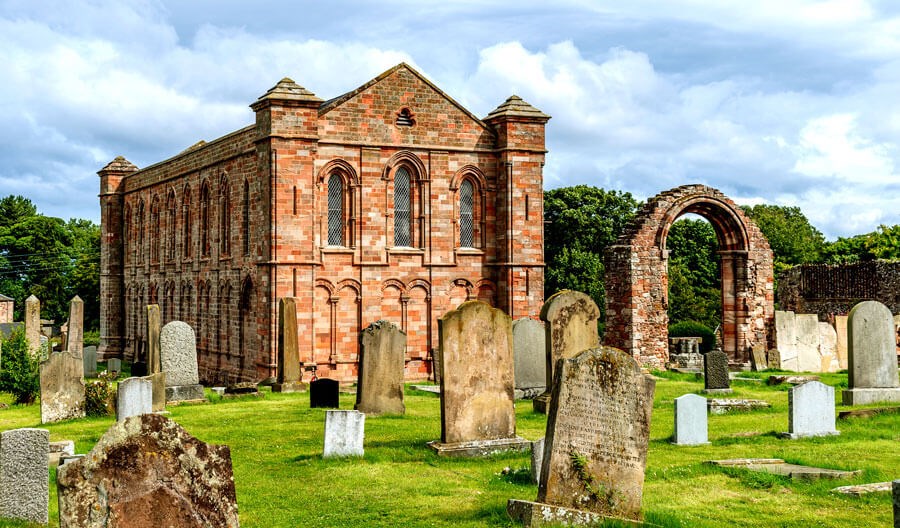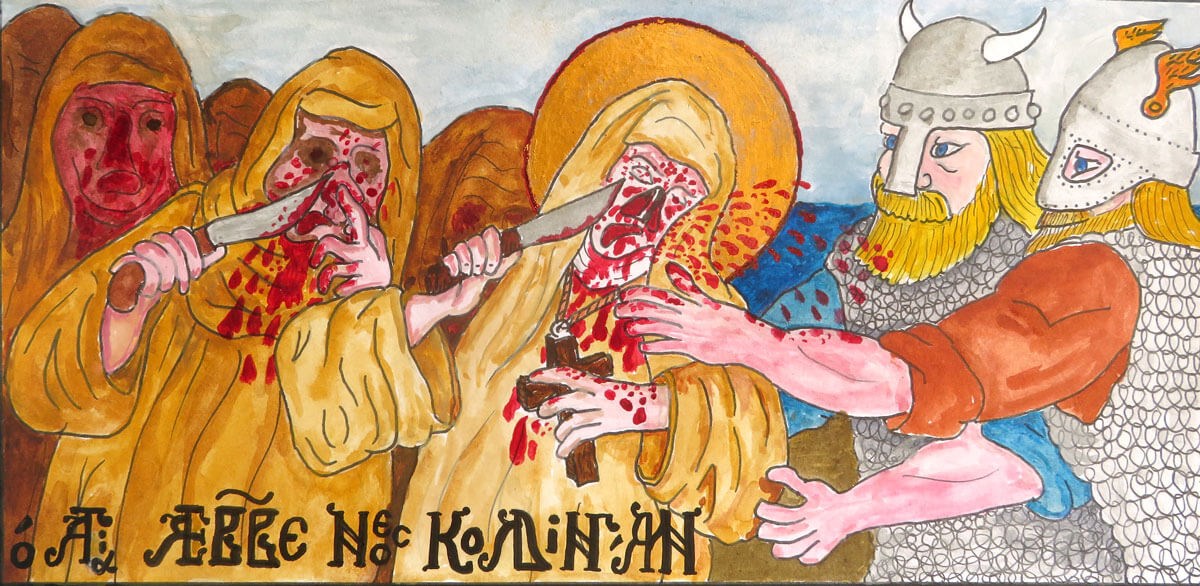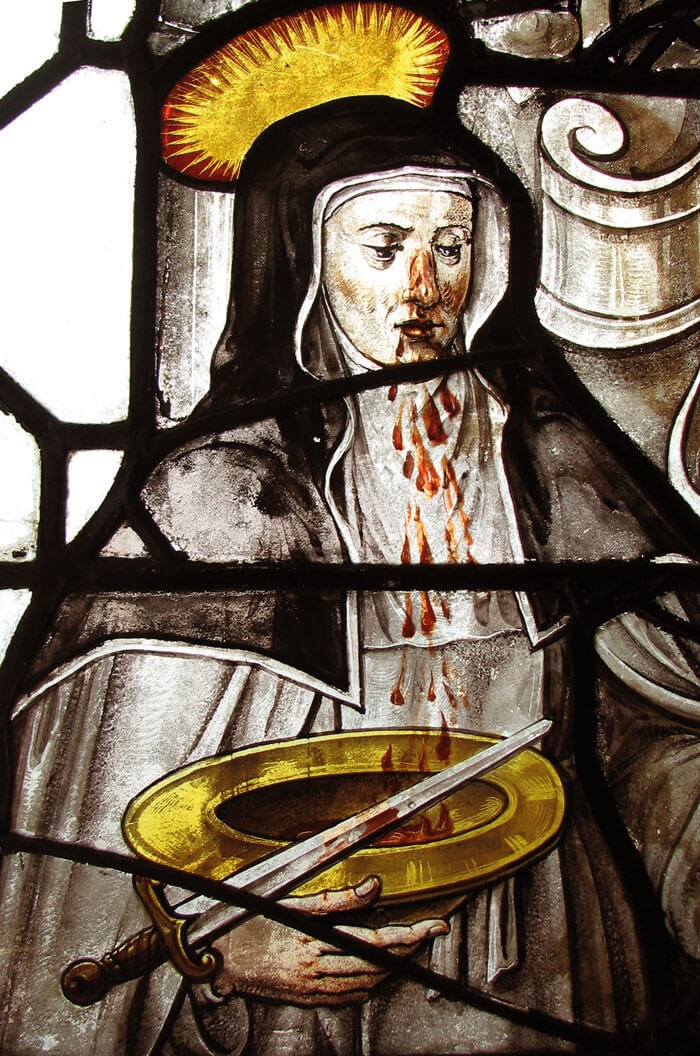Stories of the saints are often rather dark and unpleasant – and this is certainly the case with St Æbbe, as we hear from our roving historian, John Riddington Young.
In two previous articles, we have discovered the fascinating stories behind St Mamas, the saint allocated to diseases of the ear, and St Blaise, the patron saint of the throat [1,2]. These two saints are quite well known, especially in Europe, but poor old St Æbbe the Younger of Coldingham, who is assigned to the nose, is hardly recognised (and does not appear in Britannica).
To complicate matters, there were two saints called Æbbe (sometimes alternatively called Abb or Ebba) [3]. They were both abbesses of Coldingham Priory in Northumbria but, although their lives are indirectly connected, they lived some 200 years apart. Æbbe the Elder, (AD 615–683) was much better known and was a princess: the daughter of King Aethelthrif, the first king of Northumbria.
With the aid of her older brother, Oswald (later, the very well-known St Oswald of Northumbria), she established the Coldingham Monastery around AD 635, which surprisingly catered for both monks and nuns. This type of institution was known as a double separate monastery and these mixed monasteries had a definite notoriety for carnal hanky-panky. Although Abbess Æbbe, who was nominally in charge of both communities, herself maintained a chaste reputation, she could evidently do little to prevent all the fornication taking place in her abbey.

Figure 1: Coldingham Priory. Photo courtesy of British Pilgrimage Trust.
https://britishpilgrimage.org
There is an old legend that a monk foresaw in a dream that, as divine retribution for the sin and wantonness which was going on, the monastery would burn to the ground but, because Æbbe was herself chaste, that this would not happen during her lifetime. His premonition proved to be true. Shortly after Æbbe died, during all the debauched revelry and drunken orgy that immediately followed, an overturned candle caused a conflagration. The monk’s prophecy was borne out and the abbey was razed to the ground [4]. Two centuries after the fire had burned down Æbbe the Elder’s original abbey, the monastery was rebuilt but this time only as a nunnery. The abbess of the new Priory was Æbbe the Younger. Little is known of her early life [5] but, because of a dramatic turn of fate, she became patron saint of the nose (Figure 2).

Figure 2: Icon of St Æbbe based on a 16th-century black and white print study in the British Museum
by Niccolò Circignani. (NB. There is good evidence that Vikings wore horned helmets.) Painting by JRY.
On 2 April AD 874, two Viking princes, Ívarr the Boneless and Hubba Ragnarsson, were on one of their sorties of pillage, plunder and rape, and had set their sights on Coldingham. The sons of Ragnar had sworn to avenge the murder of their father by burning Northumbria to the ground (King Ælla of Northumbria had thrown King Ragnar into a pit of serpents). Hubba was one of the commanders of the ‘Great’ Viking army which invaded the British Isles in the 860s. He later died in AD 878 at the Battle of Bloody Corner in North Devon.
Abbess Æbbe was terrified when she saw the sails of the longboats approaching her Abbey, but she concocted a plan, not principally to save her life, but to maintain her precious chastity.
“When Abbess Ebba received tidings of the near approach of the pagan hordes, who had already wreaked vengeance upon ecclesiastics, monks, and consecrated virgins, she summoned her nuns to Chapter, and in a moving discourse exhorted them to preserve at any cost the treasure of their chastity. Then seizing a razor, and calling upon her daughters to follow her heroic example, she mutilated her face in order to inspire the barbarian invaders with horror at the sight” [5]. She cut off her nose and upper lip. “Filled with admiration at this admirable deed, the whole assembly followed her maternal example” [6]. “When the Danes broke into the cloister and saw the nuns with faces thus disfigured, they fled in panic” [5].
This terrible act of sacrifice preserved their chastity but not did not save their lives nor their abbey home:
“The infidels, enraged at their disappointment, set fire to the monastery, and these holy virgins died in the flames spotless victims to their heavenly spouse, the lover and rewarder of chaste souls” [7].
After this second destruction of the monastery, the ruins were not rebuilt until 1098, when King Edgar founded the Coldingham Priory, which still stands on the site (Figure 1). A cult developed around St Æbbe, but this was definitely in veneration of St Æbbe the Elder, whose bones had just been found and taken to Durham. (The term ‘invented’ from the Latin verb invenire – to find – is often used for relics; perhaps indeed it is more appropriate. Miracles were attributed to her; 43 healing miracles are reported, 30% of these for curing paralysis).

Figure 3: Painted glass panel by Jean de Caumont, depicting Blessed Oda,
from Park Abbey, near Leuven, 1640-41. Photo taken by Ellen Shortell.
Another nun who mutilated her nose to make herself sexually repellent to men was St Oda of Rivreulle, otherwise known as St Oda of Brabant and the patron saint of magpies [8] (Figure 3). She was a young 12th-century noblewoman whose parents wanted her to marry, but she fervently wished to become a nun. To avoid marriage, she disfigured her face, and cut off her nose. This seemed to convince her family that it was more than just a passing fad and they allowed her to become a Premonstratensian nun. The beautiful stained-glass window in Leuven shows that her nose is damaged, but in situ. Evidently, the sword was not initially sharp enough, but a second attempt was successful.
Schulenburg collected other stories of groups of women (some 300 virgins) who cut off their noses to protect their chastity. These seem to be communal self-mutilation to ward off rape in the ‘Dark Ages.’ In addition to the nuns of Coldingham, she cites the entire community of Saint-Cyr near Marseille and also of Saint-Florentine near Ecija, Spain. Although all their drastic actions purport to have successfully avoided rape, they were all murdered by the attackers. They considered their chastity above their very lives and have thus been acclaimed as martyrs [9].
Two centuries later, St Margaret of Hungary threatened to cut off her nose if she were not allowed to become a nun. St Margaret of Cortona followed suit. The rationale behind the actions of both Æbbe and Oda are understandable, albeit extreme [11]. Margaret of Hungary said she was worried that the threatening Mongol hordes might just attack and ravage her. Margaret of Cortona, on the other hand, was said to be strikingly beautiful and a reformed prostitute, with an illegitimate child. It is suggested that she cut her face to rid her of her beauty, which had been, after all, the root of her troubles.
References
1. Young JR. Patron saints of the ear. ENT & Audiology News 2022;31(1):29–30.
2. Young JR. St Blaise - patron saint of the throat. ENT & Audiology News 2023;31(6):44–5.
3. Farmer D. The Oxford Dictionary of Saints. Oxford, UK; OUP; 2011:133.
4. Saint Aebbe. Undiscovered Scotland. 2018.
www.undiscoveredscotland.co.uk/
usbiography/a/aebbe.html
5. Barrett M. The Calendar of Scottish Saints. 2nd ed. Fort Augustus; Abbey Press; 1919:59.
https://archive.org/details/
acalendarofscott00barruoft/mode/2up
6. Schulenburg JT. The Heroics of Virginity: Brides of Christ and Sacrificial Mutilation. In: Rose MB (Ed.). Women in the Middle Ages and Renaissance: Literary and Historical Perspectives. Syracuse University Press; 1986:45–9.
7. Bartlett AC. Male Authors, Female Readers: Representation and Subjectivity in Middle English Devotional Literature. Cornell University Press; 1995:39.
8. Shortell E. Blessed Oda’s (Un)severed Nose: Viewing Self-Disfigurement in Stained Glass from Park Abbey. Different Visions: New Perspectives on Medieval Art. 2002.
https://differentvisions.org/
blessed-odas-unsevered-nose/
Links last accessed January 2024.








